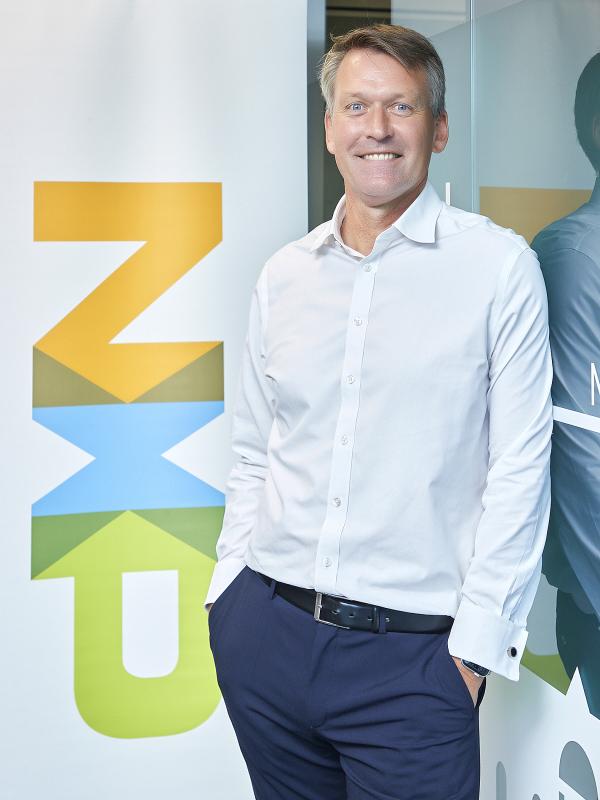NXP Semiconductors NV expects its first automotive-grade 5-nanometer chip built by Taiwan Semiconductor Manufacturing Co (TSMC, 台積電) to become available for automakers within one-and-a-half years at the earliest, following demand for better computing performance and energy efficiency for connected vehicles, a company executive said yesterday.
That would mean a significant upgrade from the 16-nanometer technology NXP adopted in its existing series of microprocessors. NXP chief technology executive Lars Reger made the remarks during a media briefing yesterday in Taipei. The latest updates came after NXP unveiled its plan to source 5-nanometer capacity from TSMC in 2021.
This is Reger’s first trip to Taiwan since the outbreak of the COVID-19 pandemic three years ago. He is slated to pay a visit to TSMC’s Fab 18 in Tainan, the hub for its 5-nanometer chips.

Photo courtesy of NXP Semiconductors NV
“We already gave silicon to our customers as a development platform. The engineering is running,” Reger said. “The new NXP S32 next-generation flagship chip will be available to OEMs in one-and-half to two years and will also be on the mass market.”
With 4 billion transistors on the new 5-nanometer processor, the S32 next-generation flagship chip would deliver optimized network connectivity in real time and enhanced computing and switching performance, Reger said. In the initial stage, no artificial-intelligence (AI) accelerator would be added on, he said.
When asked if NXP would adopt 3-nanometer technology, which has a smaller width between transistors than 5-nanometer chips, Reger said it would largely depend on the benefits brought about. If more AI applications are added on, it would trend smaller, he said.
Beyond Taiwan, NXP is also joining TSMC, Robert Bosch GmbH and Infineon Technologies AG in building a 10 billion euro fab in Dresden, Germany for making car chips in their latest efforts to boost semiconductor supply chain resilience as requested by customers.
TSMC will hold a majority stake of 70 percent in the joint venture. Construction of the fab is to commence in 2027 at the earliest.
NXP customers faced challenges to have sufficient chip supply over the past 3 years due to COVID-19-related restrictions, and have requested to source chips from multiple manufacturing sites or suppliers such as Samsung Electronics Co and GlobalFoundries Inc in different regions, Reger said yesterday.
The strategy of capacity diversification is also extended to chip packaging and development centers, Reger said. This is the “silicon shield” they want to build, he said.
TSMC is building two factories in the US to make advanced 4-nanometer chips used in smartphones and servers for Apple Inc, Nvidia Corp and AMD. The chipmaker also plans to build two factories in Japan to produce chips for Japanese automakers.

RUN IT BACK: A succesful first project working with hyperscalers to design chips encouraged MediaTek to start a second project, aiming to hit stride in 2028 MediaTek Inc (聯發科), the world’s biggest smartphone chip supplier, yesterday said it is engaging a second hyperscaler to help design artificial intelligence (AI) accelerators used in data centers following a similar project expected to generate revenue streams soon. The first AI accelerator project is to bring in US$1 billion revenue next year and several billion US dollars more in 2027, MediaTek chief executive officer Rick Tsai (蔡力行) told a virtual investor conference yesterday. The second AI accelerator project is expected to contribute to revenue beginning in 2028, Tsai said. MediaTek yesterday raised its revenue forecast for the global AI accelerator used

Taiwan Semiconductor Manufacturing Co (TSMC, 台積電) has secured three construction permits for its plan to build a state-of-the-art A14 wafer fab in Taichung, and is likely to start construction soon, the Central Taiwan Science Park Bureau said yesterday. Speaking with CNA, Wang Chun-chieh (王俊傑), deputy director general of the science park bureau, said the world’s largest contract chipmaker has received three construction permits — one to build a fab to roll out sophisticated chips, another to build a central utility plant to provide water and electricity for the facility and the other to build three office buildings. With the three permits, TSMC

The DBS Foundation yesterday announced the launch of two flagship programs, “Silver Motion” and “Happier Caregiver, Healthier Seniors,” in partnership with CCILU Ltd, Hondao Senior Citizens’ Welfare Foundation and the Garden of Hope Foundation to help Taiwan face the challenges of a rapidly aging population. The foundation said it would invest S$4.91 million (US$3.8 million) over three years to foster inclusion and resilience in an aging society. “Aging may bring challenges, but it also brings opportunities. With many Asian markets rapidly becoming super-aged, the DBS Foundation is working with a regional ecosystem of like-minded partners across the private, public and people sectors

BREAKTHROUGH TECH: Powertech expects its fan-out PLP system to become mainstream, saying it can offer three-times greater production throughput Chip packaging service provider Powertech Technology Inc (力成科技) plans to more than double its capital expenditures next year to more than NT$40 billion (US$1.31 billion) as demand for its new panel-level packaging (PLP) technology, primarily used in chips for artificial intelligence (AI) applications, has greatly exceeded what it can supply. A significant portion of the budget, about US$1 billion, would be earmarked for fan-out PLP technology, Powertech told investors yesterday. Its heavy investment in fan-out PLP technology over the past 10 years is expected to bear fruit in 2027 after the technology enters volume production, it said, adding that the tech would